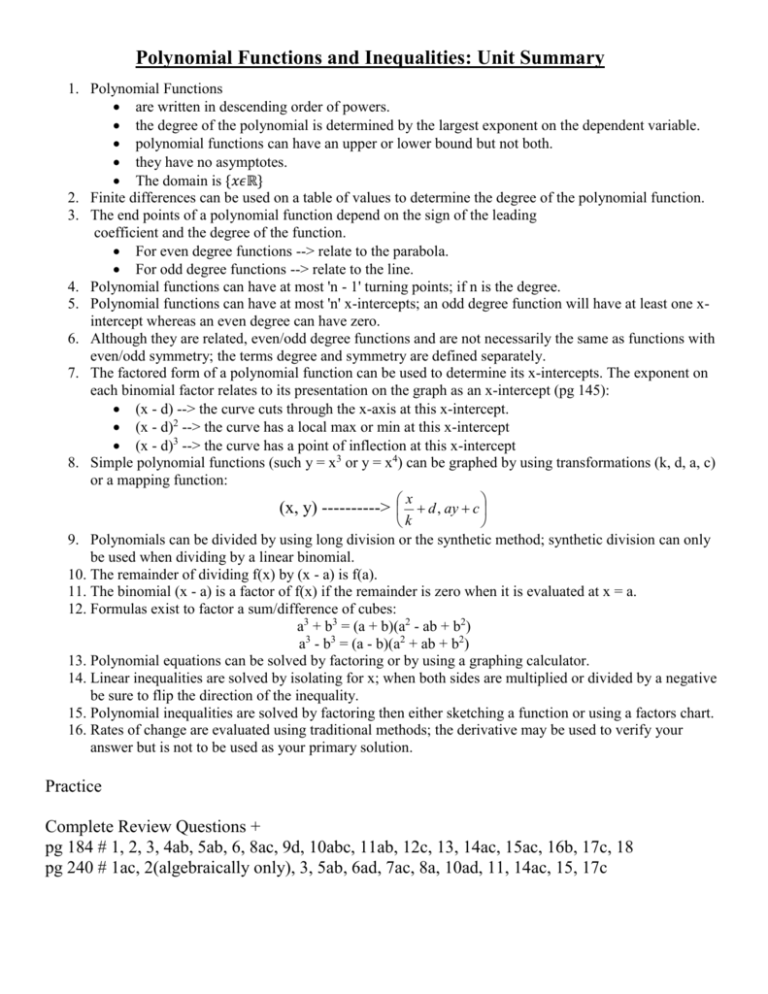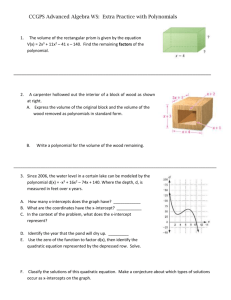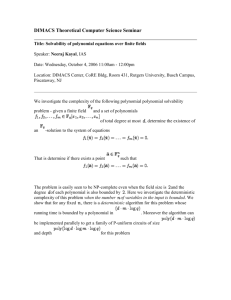Polynomial Functions and Inequalities
advertisement

Polynomial Functions and Inequalities: Unit Summary
1. Polynomial Functions
are written in descending order of powers.
the degree of the polynomial is determined by the largest exponent on the dependent variable.
polynomial functions can have an upper or lower bound but not both.
they have no asymptotes.
The domain is {𝑥𝜖ℝ}
2. Finite differences can be used on a table of values to determine the degree of the polynomial function.
3. The end points of a polynomial function depend on the sign of the leading
coefficient and the degree of the function.
For even degree functions --> relate to the parabola.
For odd degree functions --> relate to the line.
4. Polynomial functions can have at most 'n - 1' turning points; if n is the degree.
5. Polynomial functions can have at most 'n' x-intercepts; an odd degree function will have at least one xintercept whereas an even degree can have zero.
6. Although they are related, even/odd degree functions and are not necessarily the same as functions with
even/odd symmetry; the terms degree and symmetry are defined separately.
7. The factored form of a polynomial function can be used to determine its x-intercepts. The exponent on
each binomial factor relates to its presentation on the graph as an x-intercept (pg 145):
(x - d) --> the curve cuts through the x-axis at this x-intercept.
(x - d)2 --> the curve has a local max or min at this x-intercept
(x - d)3 --> the curve has a point of inflection at this x-intercept
8. Simple polynomial functions (such y = x3 or y = x4) can be graphed by using transformations (k, d, a, c)
or a mapping function:
x
(x, y) ----------> d , ay c
k
9. Polynomials can be divided by using long division or the synthetic method; synthetic division can only
be used when dividing by a linear binomial.
10. The remainder of dividing f(x) by (x - a) is f(a).
11. The binomial (x - a) is a factor of f(x) if the remainder is zero when it is evaluated at x = a.
12. Formulas exist to factor a sum/difference of cubes:
a3 + b3 = (a + b)(a2 - ab + b2)
a3 - b3 = (a - b)(a2 + ab + b2)
13. Polynomial equations can be solved by factoring or by using a graphing calculator.
14. Linear inequalities are solved by isolating for x; when both sides are multiplied or divided by a negative
be sure to flip the direction of the inequality.
15. Polynomial inequalities are solved by factoring then either sketching a function or using a factors chart.
16. Rates of change are evaluated using traditional methods; the derivative may be used to verify your
answer but is not to be used as your primary solution.
Practice
Complete Review Questions +
pg 184 # 1, 2, 3, 4ab, 5ab, 6, 8ac, 9d, 10abc, 11ab, 12c, 13, 14ac, 15ac, 16b, 17c, 18
pg 240 # 1ac, 2(algebraically only), 3, 5ab, 6ad, 7ac, 8a, 10ad, 11, 14ac, 15, 17c
Review Questions
1. State the end behaviors for the following
a) y = x3 + 2x2 + 6x + 2
b) y = -x6 + 2x3 - 5x + 1
2. Sketch a graph for the following; include all x-intercepts and the y-intercept.
a) y = -2(x+3)(x-2)(x-1)
b) f(x) = -2x4 + 12x3 - 16x2 - 12x + 18
y
y
x
x
3. Determine the type of polynomial described in the following table of values using finite differences.
x
4
6
8
10
12
14
16
18
Y
80
15
0
-1
0
15
80
255
4. Find the equation of the quartic function that has a turning point at the x-intercept 1, two other x-intercepts at 4 and
6 and a y-intercept of -48.
5. Use long division to divide the following: (8x4 + 10x3 – 16x2 + 4x – 9) ÷ (2x2 + 4x – 1).
6. Use synthetic division to evaluate the following: (x4 – 3x3 + 2x2 – x + 2) ÷ (x – 5).
7. Determine the remainder: (x3 – 6x2 + 8x – 2) ÷ (x - 3).
8. Factor.
a) 2x3 + x2 -22x + 24
b) 8x3 -125
c) 2x3 + 3x2 - 8x – 12
9. Solve the following inequality: 12x + 18 < 2x4 + 12x3 + 16x2
10. For the function f(x) = x3 - 3x2 – x + 3…
a) Evaluate the rate of change over the interval 0 ≤ 𝑥 ≤ 2.
b) Evaluate the rate of change at x = -1 then verify your answer using the derivative.







